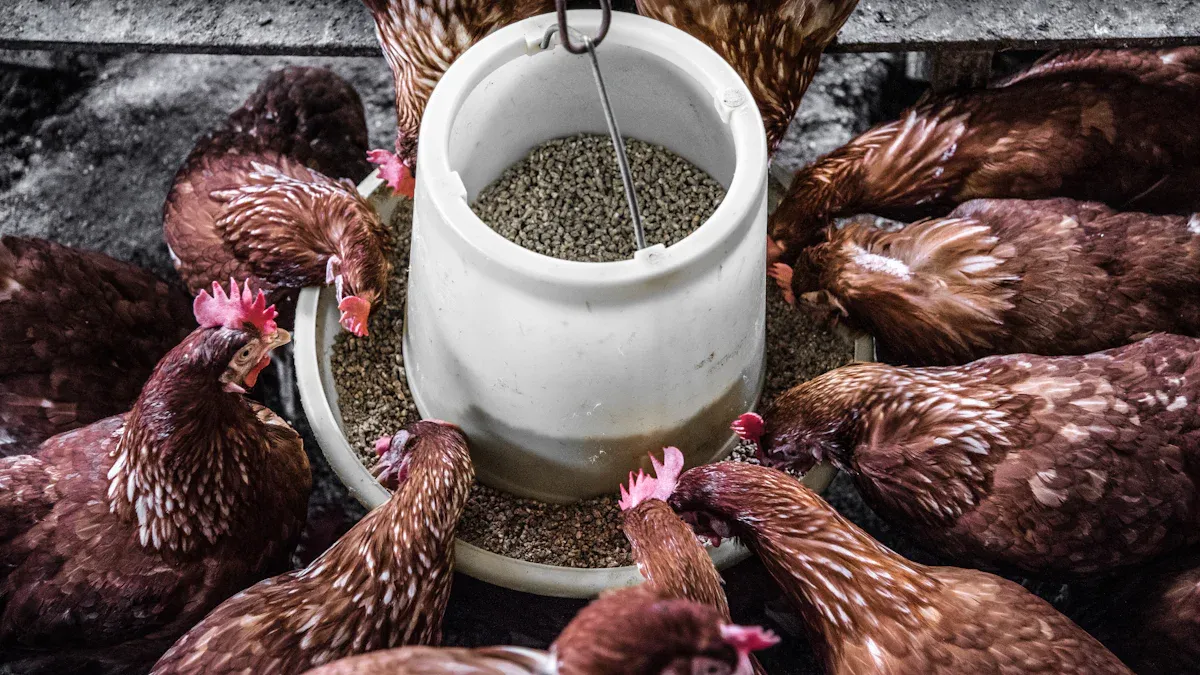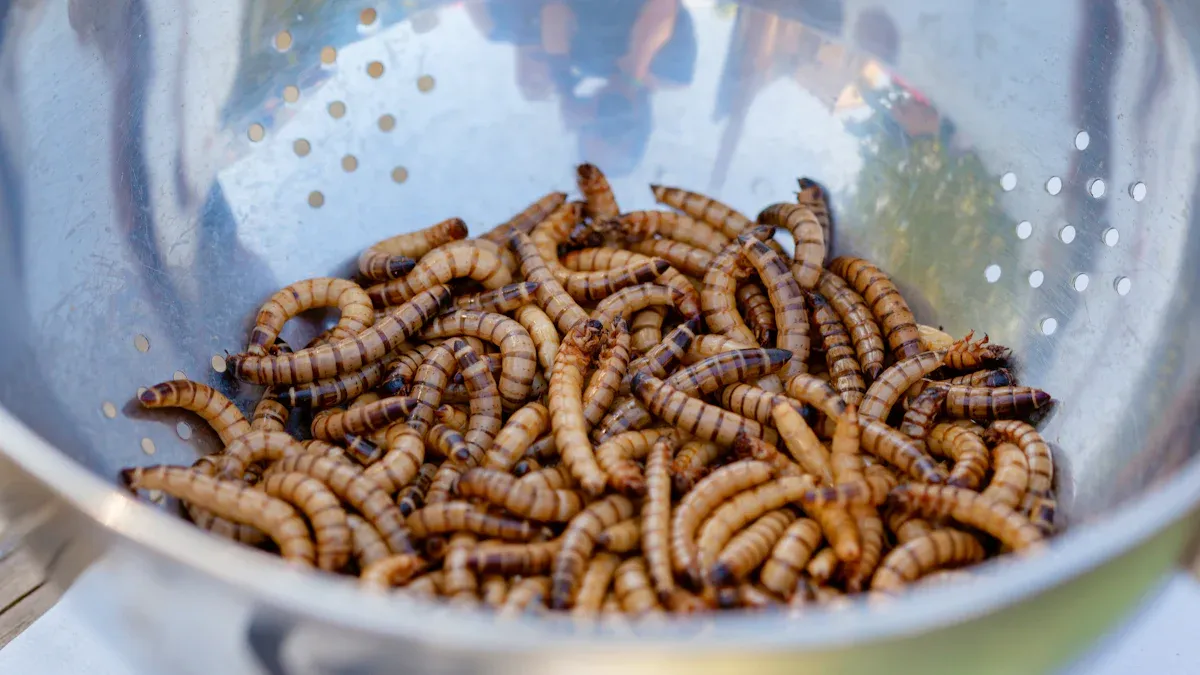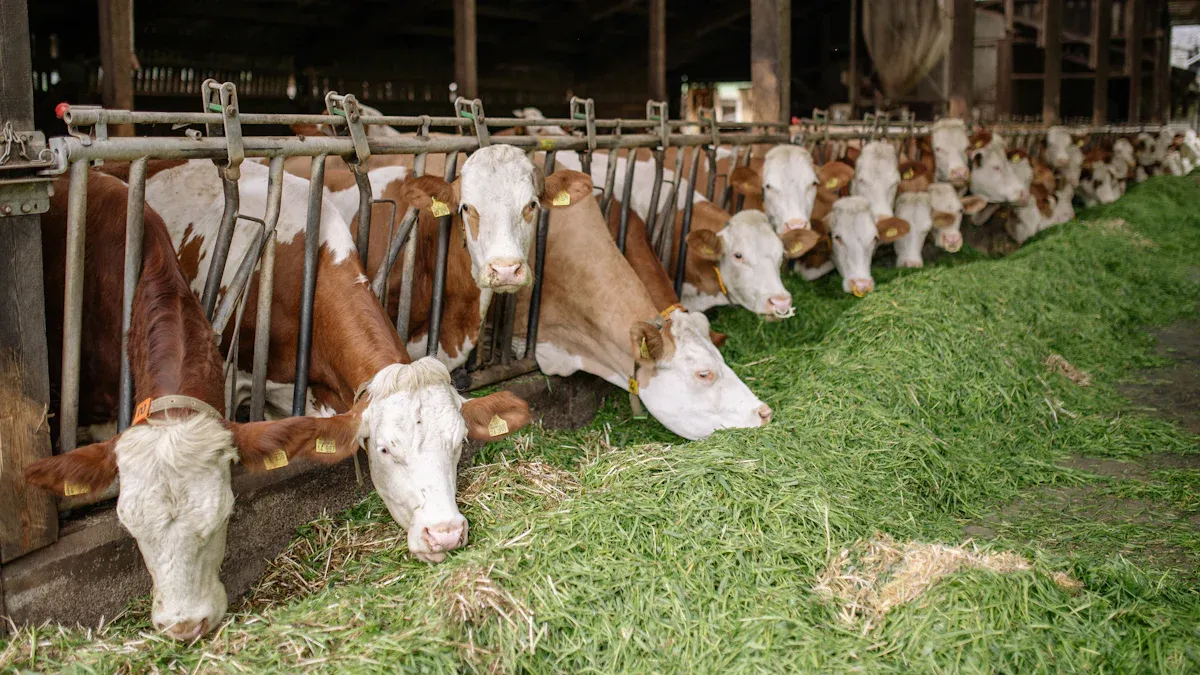
The world faces a growing demand for sustainable animal feed. By 2050, the global population could reach 9.7 billion, intensifying pressure on resources. Traditional feed practices harm the environment, depleting fish stocks and increasing pollution. Mealworm animal feed offers a revolutionary solution, combining high nutritional value with eco-friendly production to meet these challenges head-on.
Key Takeaways
- Dried mealworms are a greener choice than regular animal feed. They use less land, water, and energy and make fewer harmful gases.
- Mealworms are very healthy, packed with protein and key nutrients. They help animals grow strong and stay healthy.
- Using mealworm feed can save farmers money by reusing food waste. It is a cheap and planet-friendly way to feed animals.
Environmental and Nutritional Advantages of Mealworm Animal Feed

Lower Carbon Footprint Compared to Traditional Protein Sources
Mealworm animal feed stands out as an eco-friendly alternative to traditional protein sources like beef, chicken, and pork. Recent studies show that producing dried mealworms generates far fewer greenhouse gas emissions. They also require less land and water to produce 1 kilogram of edible protein. For example, the water footprint of mealworms is 4341 m³ per ton, which is 3.5 times lower than beef. This makes them a sustainable choice for reducing the environmental impact of animal feed production.
High Protein and Nutrient Content for Livestock and Aquaculture
Mealworm animal feed isn’t just good for the planet—it’s also packed with nutrients. Mealworms are rich in protein, essential amino acids, and healthy fats, making them an excellent source of nutrition for livestock and aquaculture. Farmers can rely on this feed to support the growth and health of their animals. Plus, its high digestibility ensures animals get the most out of every bite. This combination of sustainability and nutrition makes mealworms a game-changer in the feed industry.
Efficient Use of Resources in Mealworm Farming
Mealworm farming is incredibly resource-efficient. These insects thrive on organic waste, turning it into high-quality protein. They also require minimal space and water compared to traditional livestock. Their feed conversion efficiency rivals that of poultry, and they use nitrogen more effectively than cattle or pigs. This means mealworm farming can produce more protein with fewer resources, helping to meet the growing demand for sustainable feed solutions.
Sustainable Production of Mealworm Animal Feed

Eco-Friendly Farming Practices
Mealworm farming embraces eco-friendly practices that make it a standout in sustainable agriculture. These insects require minimal water and land, making them far less resource-intensive than traditional livestock. For instance, producing one ton of edible mealworms uses 4341 m³ of water, which is comparable to chicken but significantly lower than beef. Farmers can also raise mealworms on organic waste, reducing the need for additional feed inputs. In South Africa, small-scale farmers have already started adopting mealworms as poultry feed. This shift not only reduces reliance on conventional protein sources like soybean and fishmeal but also lowers costs and boosts income. These practices highlight the environmental and economic benefits of mealworm farming.
Circular Economy Benefits and Waste Reduction
Mealworm farming fits seamlessly into a circular economy model. By converting organic waste into high-quality protein, mealworms help reduce food waste while producing a sustainable feed source. Research shows that mealworm farming requires much less land than traditional livestock, making it an efficient way to meet protein demands. Additionally, greenhouse gas emissions from mealworm production are significantly lower than those from beef, chicken, or pork. This dual benefit of waste reduction and lower emissions positions mealworm farming as a key player in sustainable agriculture.
Scalability to Meet Global Feed Demands
The scalability of mealworm farming makes it a promising solution for global feed demands. Several factors drive this potential. For example, mealworms’ low environmental footprint and high nutritional value align with the growing demand for sustainable protein sources. Regulatory support and technological advancements are also fostering innovation in the industry. The table below highlights key drivers for scaling mealworm production:
| Key Driver | Description |
|---|---|
| Sustainability and Environmental Concerns | Mealworms have a lower environmental footprint compared to traditional livestock, requiring less land, water, and feed, while producing fewer greenhouse gases. |
| Rising Protein Demand | Global population growth and changing dietary preferences are increasing the demand for protein, positioning mealworms as a viable alternative. |
| Regulatory Support | Increased recognition of insects as a food source by governments is fostering investment and innovation in the mealworm industry. |
| Technological Advancements | Innovations in farming and processing are improving the efficiency and scalability of mealworm production. |
These factors demonstrate how mealworm farming can scale up to meet the protein needs of a growing population while addressing environmental concerns.
Market Potential and Economic Benefits of Mealworm Animal Feed
Growing Demand for Sustainable Feed Solutions
The demand for sustainable feed solutions is growing rapidly. As the global population increases, so does the need for protein-rich animal feed. Mealworm animal feed is emerging as a popular choice due to its high nutritional value and eco-friendly production. Market reports highlight this trend.
- The mealworms market was valued at USD 9.29 million in 2023.
- It is projected to reach USD 17.66 million by 2031, growing at a CAGR of 7.4% from 2024 to 2031.
Farmers and feed producers are increasingly turning to mealworms as a sustainable protein source for livestock. Their rich protein content, healthy fats, and essential amino acids make them ideal for poultry, swine, and aquaculture. This shift reflects a broader trend of incorporating alternative proteins into animal diets.
Cost-Effectiveness for Farmers and Feed Producers
Mealworm animal feed offers significant cost advantages. Farmers can raise mealworms on organic waste, reducing feed input costs. Additionally, mealworms require less land, water, and energy compared to traditional protein sources. This efficiency translates into lower production costs for feed producers.
For example, mealworms’ ability to thrive on organic byproducts minimizes waste and maximizes resource use. This not only saves money but also aligns with sustainable farming practices. As a result, mealworm feed provides an affordable and environmentally friendly option for farmers worldwide.
Opportunities for Innovation in the Feed Industry
The rise of mealworm animal feed opens doors for innovation in the feed industry. Companies are exploring new technologies to improve mealworm farming and processing. These advancements aim to enhance production efficiency and scalability.
Key opportunities include:
- Developing automated farming systems to reduce labor costs.
- Creating specialized mealworm-based feed products tailored to different livestock needs.
- Expanding research into mealworm nutrition to optimize animal health and growth.
With sustainability and rising protein demand driving the market, mealworm feed represents a promising frontier for innovation. Its lower environmental footprint and high nutritional value make it a game-changer in the quest for sustainable animal feed solutions.
Overcoming Challenges in Mealworm Animal Feed Adoption
Addressing Regulatory and Policy Barriers
Regulations often slow down the adoption of innovative solutions like mealworm animal feed. Many countries still lack clear policies for using insects in animal feed. This creates uncertainty for farmers and feed producers. Governments need to establish guidelines that ensure safety while encouraging innovation. For example, the European Union has approved certain insect proteins for aquaculture, but broader approvals are still pending.
Tip: Collaboration between policymakers, researchers, and industry leaders can help create a supportive regulatory framework. This will pave the way for mealworm feed to become a mainstream option.
Changing Consumer Perceptions and Awareness
Consumer perception plays a big role in the success of mealworm feed. Many people feel hesitant about insects as a food source, even for animals. Education is key to overcoming this barrier. Sharing success stories from farmers who have switched to mealworm feed can help build trust. Highlighting the environmental and nutritional benefits also makes a strong case.
Social media campaigns and community outreach programs can spread awareness. When consumers understand the positive impact of mealworm farming, they are more likely to support it.
Technological Innovations to Enhance Production Efficiency
Technology can make mealworm farming more efficient and scalable. Automated systems for feeding, harvesting, and processing mealworms reduce labor costs. Innovations like vertical farming maximize space, allowing farmers to produce more protein in smaller areas.
Researchers are also exploring ways to improve mealworm diets. By optimizing what mealworms eat, farmers can boost their protein content. These advancements make mealworm farming a practical and profitable choice for feed producers worldwide.
With the right technology, mealworm farming can meet the growing demand for sustainable animal feed.
Dried mealworms offer a sustainable, nutrient-rich, and cost-effective solution for animal feed. Their low environmental impact and high scalability make them a game-changer in the feed industry.
Stakeholders have a unique opportunity to embrace this innovation. Investing in mealworm-based feed can drive sustainability while meeting the growing demand for protein worldwide.
FAQ
What makes mealworms a sustainable feed option?
Mealworms require less water, land, and energy to produce compared to traditional protein sources. They also thrive on organic waste, reducing environmental impact. 🌱
Can mealworm feed be used for all types of livestock?
Yes, mealworm feed works for poultry, swine, and aquaculture. Its high protein and nutrient content make it versatile for various animals.
Are there any safety concerns with using mealworms in animal feed?
Mealworms are safe when farmed and processed under proper guidelines. Regulatory approvals ensure their quality and safety for animal consumption.
Tip: Always source mealworm feed from certified producers to ensure quality and compliance with safety standards.


